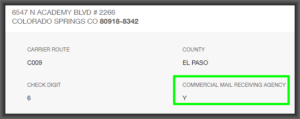The Commissioner for Trademarks has for more than two years now demanded to know, for each trademark applicant, “where you sleep at night”. It’s not good enough to provide a post office box because, in the words of the previous Commissioner, “in most cases, a post office box address is not a domicile because you can’t live in a P O box.” The Examining Attorneys always pounce on any trademark application for which the applicant’s address is a P O Box, demanding that the applicant reveal his or her “where you sleep at night” address.
The Commissioner does not, however, seem to act very consistently in his efforts to ferret out instances of an applicant failing to reveal where he or she sleeps at night.
I pointed this out in a March 27, 2020 blog article entitled Trademark Office misses a chance to demand that a trademark owner reveal where it sleeps at night. In that blog article I pointed out that the address provided by the applicant was the street address of the post office where the applicant’s P O Box was located. The case proceeded to registration, and to this day the Commissioner has failed to force the applicant to reveal where it sleeps at night.
I pointed this out in a February 7, 2020 blog article entitled The Commissioner for Trademarks definitely discards the CMRA data that it receives from the USPS. In that blog article I gave examples of cases where the USPTO actively disregarded information that it receives from the US Postal Service database that flags addresses that are CMRAs (Commercial Mail Receiving Agencies).

Now in 2021, the interesting question is whether the Commissioner has perhaps finally gotten around to making use of the CMRA information that it receives from the USPS. See for example this application which was filed on November 10, 2020 and that has just recently reached the desk of an Examiner. In this application, the applicant lists its address as 6547 North Academy Boulevard #2266, Colorado Springs, CO 80918. Maybe tomorrow, maybe next week, maybe the Examining Attorney in this case will demand to know where the applicant sleeps at night. I wonder if the Examining Attorney in that case will do so.

Anyone sitting at home in their pajamas can do the couple of mouse clicks that are required to find out (from the USPS zip code database) that this is the address of a Commercial Mail Receiving Agency (see screen shot). Any competent computer programmer can write code that would do this lookup automatically in the USPS’s API for this database. Here is what you see if you go to that address. This is a Mail Center that offers “mail box rentals”.
See also this application where the applicant listed the same Mail Center address, and the Examining Attorney did not demand to know where the applicant sleeps at night.
You can do a TESS search for “(6547 )[OW] and (Academy)[OW] and live[ld]” and you will find no fewer than 2300 live US trademark applications for which the applicant has listed this Mail Center as its address. I am astonished, in a good way, to see that in a few cases (for example this one) the Examining Attorney did figure out that the address is a CMRA. But in the majority of cases (for example this one which is now registered) the Examining Attorney snoozed through it.
So it is quite clear that the Commissioner is not even now using the USPS API to flag applications that make use of CMRAs. Yes, some individual Examining Attorneys occasionally check to see if a suspicious-looking applicant is making use of a CMRA. But there is no consistent checking of the USPS database even now, a year after I first pointed this out to the Commissioner.
